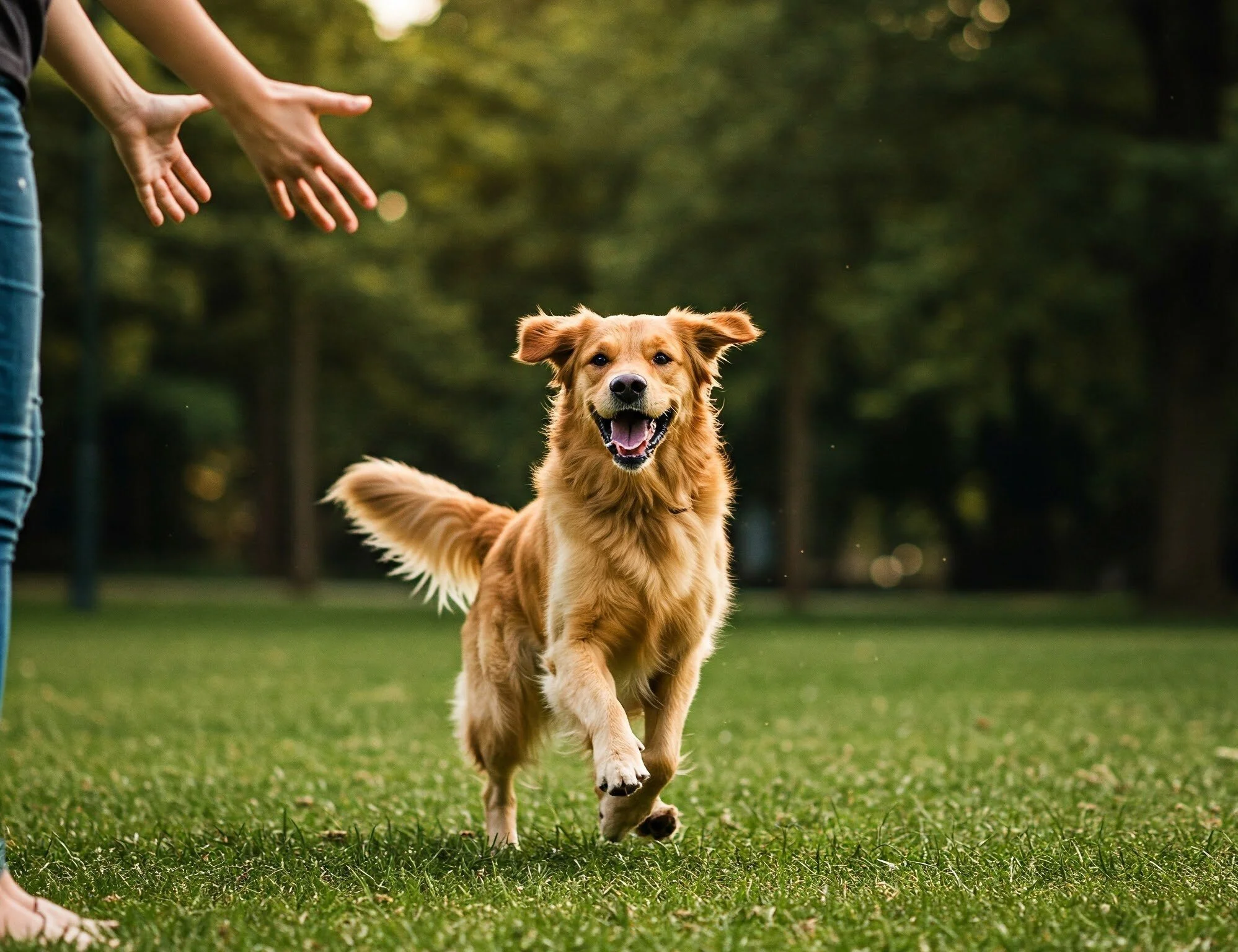Ready! Steady! Recall! - The Power of a Solid Recall
Imagine calling your dog and watching them immediately whip around and race back to you—full of enthusiasm, no hesitation, no detours. That’s not just a party trick. A reliable recall is one of the most important—and potentially life-saving—skills you can teach your dog. Whether you’re avoiding a squirrel-fueled sprint toward traffic or simply wrapping up a romp at the park, a fast, consistent recall gives you freedom, peace of mind, and a stronger relationship with your dog.
But building that kind of recall takes more than just shouting their name louder.
DO:
Start in low-distraction environments.
Use high-value rewards—think turkey, cheese, or whatever your dog flips for.
Keep your tone happy and inviting. Sound like a party, not a drill sergeant.
Reinforce every single recall generously in the beginning.
Practice often and make it fun!
DON'T:
Don’t call your dog to you for things they hate (like nail trims or leaving the dog park).
Don’t repeat their name like a broken record.
Don’t scold them when they finally come—no matter how long it took.
Don’t rush the process. Trust builds through repetition and reward.
What You’ll Need:
A long line (15–30 feet is ideal for safety and flexibility)
High-value treats or a favorite toy
A clicker or marker word (like “yes!”)
A flat collar or harness
Patience—and a sense of humor helps too
Building the Behavior: The Food Toss Game
Before we expect our dogs to recall in the wild chaos of the great outdoors, we need to teach them what coming when called actually means—and make it deeply rewarding. One of our favorite ways to lay that foundation is with a simple food toss game that builds speed, clarity, and fun.
How to Play (Indoors to Start):
Set up in a small space, like your living room or hallway. Have your dog on a short leash or dragging a line if needed.
Toss a piece of food a few feet away and let your dog go get it.
As soon as they eat it, say your recall cue (“Fido, come!” or just “Come!”) in a happy voice.
When they turn and head toward you, mark it with your clicker or marker word.
As they reach you, gently grab their collar or harness—just a second or two of light contact.
Then reward them generously: several small treats or one big payoff.
Adding the collar grab before delivering the reward prevents the common “drive-by snack” issue where dogs learn to swoop in, grab the treat, and bolt. It also prepares them for real-world situations where you'll need to leash them up or stop them from dashing off again.
Taking It Outside:
Once your dog is enthusiastically boomeranging back indoors, it’s time to take the game to the backyard or a quiet park with your long line clipped on. Start easy:
Keep distance and distractions low at first.
Practice short tosses and clear recalls.
Stay animated and generous with rewards.
The goal is to transfer the reflexive, happy recall from your house to real-world environments—without losing clarity or excitement.
Taking It on the Road: Distractions, Distance & Ditching the Long Line
Once your dog is consistently nailing their recall game in controlled settings, it’s time to raise the bar. Real life isn’t distraction-free—so your training can’t be either. Gradually adding challenge helps your dog generalize the recall cue and stay responsive no matter what’s going on around them.
Leveling Up Distractions:
Start small and increase gradually. Some ideas:
Practice in a quiet park before heading to a busier one.
Add movement: jog backward as you recall, or recall from behind a tree.
Add competing motivators (at a safe distance): other dogs, squirrels, bikes, smells.
Use “real world” recalls during play breaks or before meals.
If your dog struggles with a new level of distraction, don’t repeat the cue—just calmly guide them in with the long line and try again at an easier level next time. Success builds confidence, and confidence builds reliability.
The Long Line - Training Wheels for Recall:
Think of the long line like a seatbelt—it keeps your dog safe while giving you space to build independence and trust. But eventually, we want to fade it out.
Here’s how to do it thoughtfully:
First, let the line drag without holding it unless needed. This gives your dog a taste of freedom while keeping safety backup in place.
Begin practicing recalls off-leash in fenced or enclosed spaces—tennis courts, baseball fields, or secure dog parks during quiet hours.
When your dog is hitting a high success rate (80–90%) around distractions, start dropping the line for short off-line sessions, then gradually phase it out altogether.
Remember: freedom is earned, and the long line is a tool, not a crutch. Use it until your dog consistently proves they can handle the responsibility.
Ready to Go Pro? Join Us at Grad School or Group Class!
If you're fired up about getting a rock-solid recall, we’re here to help take your training to the next level.
Our Grad School is designed for dogs who’ve completed foundational training and are ready to apply their skills in real-world settings. We work on advanced recall, off-leash reliability, and impulse control—all while your dog has a blast learning alongside their peers.
Prefer to train alongside your pup? Our Group Classes offer hands-on coaching, personalized feedback, and a supportive environment where both dogs and handlers grow. Whether you're polishing up your recall or rebuilding it from scratch, we’ve got a class for you.
🔔 Spots fill fast, so don’t wait—head over to our website or reach out directly to reserve your place. Your dog’s freedom—and your peace of mind—starts with a great recall.

